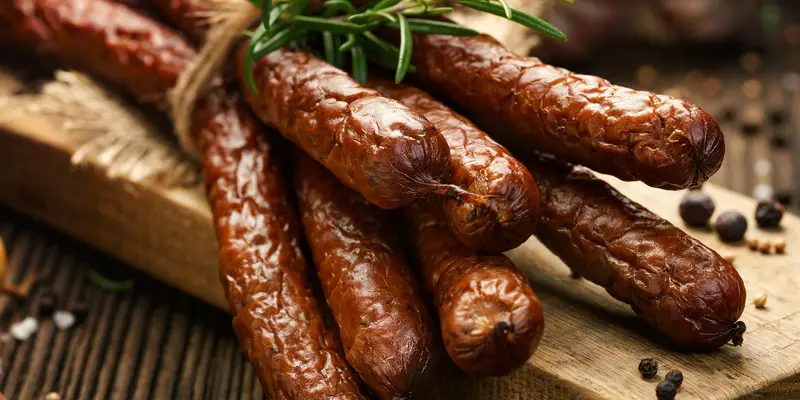Kabanosy is a hugely popular Polish sausage. Many would argue it’s the best stick of meat you can eat. Its popularity has been maintained over the decades thanks to its hearty, warm, full-of-flavour characteristics. It also has an impressive shelf life in ambient conditions, thanks to it’s drying process.
The name, Kabanosy, stems from the nickname “kabanek” which is given to a fat pig still in its infancy. Interesting, considering that this sausage is actually quite thin.
In previous centuries, the Poles had a unique method for testing whether the sausage was up to standard. They’d drop it from their waste and the sausage needed to break into pieces to pass the quality check. It was a surprisingly effective technique!
How Kabanosy differs from other sausages
The traditional method of making Kabanosy was to stuff the meat into sheep casings. Thanks to the smoking, baking and drying process, the meat would lose a significant amount of moisture. This is what gave the sausage a thin, hard, withered appearance.
Kabanosy is roasted in a smoke house after they’ve been smoked. This differs from many other sausage types that are cooked in water after smoking. It is this roasting that allows Kabanosy to remain edible, even when left in ambient storage for prolonged periods.
What are the dominant spices in Kabanosy?
Polish authorities state that caraway and nutmeg are the main spices; however, over time many variations have evolved. In the U.S., there are a huge variety of Kabanosy recipes available.
Best casings for Kabanosy
To make the perfect Kabanosy, true to it’s heritage, you’ll need to use natural sheep casings. Although many butchers stock them in my city, I have found they aren’t widely available in other parts of the world. You may need to look at sourcing them online.
Recommended wood for smoking Kabanosy
- cherry
- beechwood
- walnut
- hickory
How to make Kabanosy the old-school way
When you start your search for the perfect Kabanosy, you’ll find many recipes that tell you to mix the ingredients thoroughly – to the point that it’s a gluey texture. This results in an unpleasant, rubbery meat stick that should be avoided. It is better to fold the meat until the spices are evenly distributed and then stop. This will help produce a sausage that improves flavor and imparts a snap when you take a bite.
If you have never made sausages before, I recommend you read this guide on how to make sausages.
Ingredients
- 2 1/2 pounds pork (30% hind leg)
- 10 ounces pork fat
- 3 Tbsp. Kosher salt
- 2 tsp sugar
- 1/2 tsp Instacure #1
- 2 tsp black pepper
- 2 tsp nutmeg
- 1/3 cup water (iced)
- 2 tsp caraway seed
Method
- Chop pork meat and fat into suitable pieces to fit your grinder.
- In a large bowl, mix seasonings into the meat. Remember not to mix too thoroughly (see above comment on improving your Kabanosy). Add mixture to the freezer for one hour.
- As the mixture chills, remove casings and run some water over (and through) them. Then leave to soak in a bowl of water. Leave one end of each casing hanging over the edge of the bowl for easy access.
- Process the meat through your grinder then place in fridge for 30 minutes so that the meat cools further.
- Add meat to sausage stuffer and attach a casing to the stuffer’s nozzle. Aim for links that are at least 12″ – you can increase the length to 24″ if you prefer. Cut the casing then carry on making more links with the remaining meat.
- Pierce the casings with a needle if you see any air pockets then tie the ends of each casing together.
- Find a cool, dry location and hang the links for at least 3 hours. If your weather is over 75°F you’ll only need to hang for 1 hour.
- Add you sausages to a smoker for around four hours. The meat’s interior needs to reach 150°.
- Once the Kabanosy has cooled, hang them for 3-5 days in a dark space that’s between 35°F to 55°F.
- Store refrigerated or freeze to help extend shelf life.



Leave A Comment